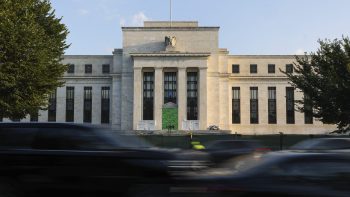Federal Reserve after the bailouts
TEXT OF INTERVIEW
Kai Ryssdal: Alongside its interest rate announcement today — that interest rates are going to stay right where they are — the Federal Reserve said something else in its statement. That it’s going to start easing off one of the big lending programs it put in place when the credit crisis was at its worst. That is what you call a perfect segueway to let us pick up on something we started yesterday, a discussion of exactly how to unwind some of those things the government has done over the past year or so to help keep the economy afloat.
If you thought banks paying back $700 billion in TARP money was tricky, try figuring out what’s going to happen when the Federal Reserve pulls back its trillions of dollars in support. Alice Rivlin is senior fellow at The Brookings Institution. She’s also a former vice chairman of the board of governors at the Federal Reserve. Mrs. Rivlin, welcome to the program.
ALICE RIVLIN:: Good to be here, Kai.
Ryssdal: If I could have you remind us — using as few acronyms as possible — some of the ways the Federal Reserve has been bailing out this economy the past year or 18 months or so.
RIVLIN: The Federal Reserve has done some truly remarkable things. They first facilitated the rescue of Bear Stearns, the rescue of AIG. They opened the discount window where commercial banks have always been able to borrow to banks that were not commercial banks, investment banks. And they began buying up securities backed by assets like credit cards and mortgages to make sure that credit is flowing to people who want to borrow it to buy a house or to buy a car or to buy something on their credit card. So they entered into the financial markets in a big way.
Ryssdal: On the order of trillions of dollars, right?
RIVLIN: Absolutely.
Ryssdal: Do me a favor and do a little bit of compare and contrast would you, between the TARP, that bank bailout, and the Federal Reserve programs, and how unwinding those might be different.
RIVLIN: The TARP was originally supposed to buy toxic assets from the banks. It never actually did that. But it invested, the Treasury invested, directly in the banks. And the wind-down process there will be the banks paying the Treasury back. Some of them already have. The lending programs of the Federal Reserve are actually more complicated, and they are quite a large number of them. And they will wind down as the Federal Reserve sees the private markets taking over.
Ryssdal: And what’s the mechanism by which the Federal Reserve starts pulling back some of this money? Do they just go to the banks and the dealers in New York and say, OK, we’re not going to do as much now?
RIVLIN: In effect, yes. Or they just stop doing as much. And they can certainly get back to something normal in a reasonable period, but they won’t do it quickly.
Ryssdal: Let me ask you this just as a hypothetical. What happens if tomorrow the Fed just shuts off all its programs?
RIVLIN: That’s not going to happen because it would be much too worrisome. The financial system has become dependent on borrowing from the Federal Reserve in very large amounts. And shutting it off quickly would put us back into a financial crisis. Nobody’s going to do that.
Ryssdal: We had Tony Sanders from George Mason University on yesterday. And we asked him this question: How long it’s going to take to unwind the TARP investments, the big bank bailouts. He said, you know, three or four years, about that. What’s your take on how long it’s going to take to unwind some of these Fed investments, given that they’ve already started?
RIVLIN: A lot depends on what happens to the economy, and how the financial sector responds. The whole point is to get the financial sector stabilized, which seems to have happened. And get them lending again, so that the real economy can recover. And we don’t know exactly how long that’s going to take or whether there might be some problems still to come. A lot people are worried about commercial real-estate loans. And those may be on the books of a lot of community banks. They may not be worth as much as they thought. There may be some problems still to come.
Ryssdal: Alice Rivlin, a senior fellow at The Brookings Institution. Ms. Rivlin, thanks so much for your time.
RIVLIN: Delighted to be here.
There’s a lot happening in the world. Through it all, Marketplace is here for you.
You rely on Marketplace to break down the world’s events and tell you how it affects you in a fact-based, approachable way. We rely on your financial support to keep making that possible.
Your donation today powers the independent journalism that you rely on. For just $5/month, you can help sustain Marketplace so we can keep reporting on the things that matter to you.


















